EQUINE WELFARE NETWORK PROFILE
Beyond The Roses Equine Rescue & Retirement
http://www.beyondtherosesequine.org

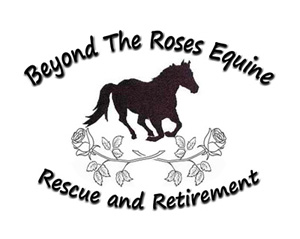
Beyond The Roses Equine Rescue & Retirement
11621 Bryce Road
EMMETT, MI 48022
Mailing Address:
11621 Bryce Road
EMMETT, MI 48022
Phone: 586-321-6780
MAKE AN INQUIRY
View our WEBSITE
EIN: 45-4360903Founded: 2012
View our PHOTO GALLERY
Profile Last Updated June 22, 2025Public Charity
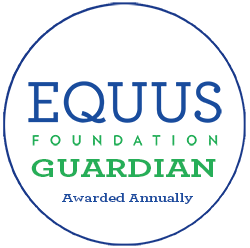
2025
The Guardian Seal of Transparency is awarded annually to recognize an organization's commitment to transparency and accountability by their willingness to make comprehensive data about their programs, horse care practices, and governance available for public scrutiny. The Guardian Seal of Transparency is NOT an endorsement.
Awarded Annually
Last Updated: November 30, 2025
Last Updated: November 30, 2025
Teeticket
Our Equine Ambassador

Teeticket began her racing career on February 24, 2016. She had 22 racing starts, placing first twice, second once and third three times with a lifetime earnings of $22,512. Teeticket was retired from racing in 2018. She was acquired by a Kill Pen Buyer in 2019 from an Amish family when she could no longer serve her purpose of pulling a cart. Beyond the Roses Equine Rescue (BTRE) fundraised and purchased her to save her from going to Canada for slaughter. We were told at the time that she was blind in at least one eye. When arriving at our farm Teeticket was examined by our Veterinarian and it was thought that she had Uveitis in both eyes and was blind in both. We then took her to Michigan State University Large Animal Clinic to be examined. They verified she was completely blind. BTRE was told that the best avenue for Teeticket would be to remove her eyes so she would not be in pain. In June 2020, the funds were raised and her eyes were removed. Since BTRE had never had a blind horse before, modifications needed to be made to give her comfortable surroundings. A small turnout was created for her to be turned out into and her stall was modified for her. She adjusted very well to her new lifestyle. Teeticket was a very cooperative horse. Very friendly and an easy to work around. Last October BTRE rescued a mare named Hope This Helps (Hope). Hope and Teeticket have been housed next to each other and immediately became friends. They are now inseparable and Hope has become Teeticket’s new eyes. They were moved to a larger paddock attached to their stalls. Teeticket gets around the paddock as if she can see. She has been taught voice commands so it is easier for her to be handled. It was determined that with Teeticket’s blindness it would best for her to be a Sanctuary horse with BTRE and live out her life with us. She appears to be very happy with her new life as a Sanctuary horse with us.
MISSION & PROGRAMS
Mission:Beyond The Roses Equine is an all volunteer group whose mission is to provide racing thoroughbreds, and other breeds of horses, an alternative to being sent to slaughter for human consumption or ending their careers being abandoned or neglected and to educate people in their care and welfare. Beyond The Roses Equine offers horses of all age's rehabilitation, retraining and placement into approved homes that will offer them second careers.
Our organization provides programs involved with equine rescue, adoption & retirement
Our organization provides outreach and/or public education programs involving horses.
100% of our total programs and services are equine-related.
Our organization is directly responsible for the care and shelter of equines involved in our programs.
Our organization does not CURRENTLY use satellite, overflow, foster, and/or outreach facilities.
Please describe what steps your organization takes to ensure that:
1) all interactions between your equines and people are mutually beneficial and conducted in accordance with the Guidelines for Human-Equine Interactions stated below;
2) all equines in the care of our organization and/or equines that participate in the organization's program have access to clean drinking water at all times; nutritious food in sufficient quantity, including natural forage such as pasture grass and/or hay; appropriate veterinary, farrier, and dental care; shelter and protection from the weather; sufficient safe space to move around comfortably on a daily basis; and daily opportunity to freely interact and have contact with other equines:
The horses with Beyond The Roses Equine Rescue cannot be ridden but do help our volunteers deal with anxiety and depression. By interacting with the horses, it allows the horses and individuals build trust and confidence while around them. Horses deserve respect, compassion, and responsible stewardship. Human-equine interactions must be guided by ethical principles that prioritize their well-being. This includes providing adequate nutrition, shelter, and medical care and ensuring humane training methods that respect the horse’s physical and mental limits. Whether through therapy, sport, or casual companionship, horses remain a symbol of grace, strength, and partnership--a reminder of the extraordinary ways in which two species can enrich one another.
Persons and anyone interacting with the BTRE horses will follow the written Procedures and Policies of the program. The horses are separated by gender and necessary care. All of our horses live outside and have access to clean water and hay 24/7. They also all have round bales available to them in each paddock. We also have a 5-acre pasture that is available spring, summer and fall. Horses are fed grain twice a day or more if needed. Horses receive vaccines as needed yearly and examined on a regular basis by our veterinarians. Shelters are provided in each paddock to protect them from inclement weather. The number of horses in each paddock is limited to provide ample space to move around and interact with each other.
Equine Transition Services:
Overview of our programs involved with rescue, rehabilitation, retraining, re-homing and/or retirement:
Beyond The Roses Equine Rescue and Retirement, aka BTRE, is an ALL VOLUNTEER organization that transitions thoroughbreds off the racetrack into new careers and all other breeds of horses, into approved, loving homes from all over the United States. Beyond The Roses Equine Rescue and Retirement’s has many volunteers that have been, in the past, been involved in horse rescue and have years of experience rehabilitating, retraining and marketing thoroughbreds and other horses into new homes and careers. Without the help of BTRE, many of these horses would be sent to auctions where they would be picked up by kill buyers and sent to slaughter.
This group has been involved with thoroughbred and horse rescue with other 501c3 groups and each other. Racing trainers approach us when they don’t have the time or they are unable to find homes for their horses, when they can no longer compete in racing. We also help horses that have been neglected, abused or unwanted. Many of these horses come to us severely underweight and in need of medical care. Veterinarians work with us to evaluate medical conditions when they first arrive at our farms.
While building the horses up to good condition, experienced horse people work with them to evaluate their abilities to be riding horses. Many can be used for trail, dressage, jumping or for pasture companions. In the mean time, BTRE markets to fine them suitable homes.
Beyond The Roses Equine Rescue and Retirement also assists racing owners and trainers and other people in need of help, in finding homes themselves, by listing horses on Beyond The Roses Equine Rescue and Retirement’s website at www.beyondtherosesequine.org . Beyond The Roses Equine Rescue and Retirement volunteers talk with trainers and owners and take pictures and descriptions of horses they wish to sell. Often, if homes cannot be found, Beyond The Roses Equine Rescue and Retirement is asked to take the horse into our program. These horses are taken to one of our farms or foster homes, where the horses are photographed with pictures and descriptions immediately posted to Beyond The Roses Equine Rescue and Retirement’s website. Funds for veterinary care and feed and general care are provided for by Beyond The Roses Equine Rescue and Retirement.
Beyond The Roses Equine Rescue and Retirement uses the internet, using Facebook and other horse rescue forums and blogs, to fundraise to help these horses. The internet resources are also used for marketing to find them homes. BTRE also applies to other organizations and foundations that provide grants to help these horses.
Outreach and/or Public Education:
Educate the public on social media in horse care. Also attend and display at Expos to extend our knowledge to the public.
Research/Medical Use of Equines:
Our organization has made equines available for research studies or medical training.
Please explain where and for what purpose equines are/were provided to use in research or medical training.
Occasionally Michigan State University will euthanize a horse for us. In these cases, they have our permission to use the carcasses, after euthanizing, to use for training purposes for the students in their veterinary program.
Religious Affiliation:
Our organization does not promote religious education, religious purposes, or a specific religious faith or use donations for religious education or religious purposes; require participants to be of a certain faith; require participation in religious, instruction, activities or services; or require participation in prayer, worship, religious instruction or other religious activities as a condition of receiving social or secular services offered.
Auction Donation:
Our organization has never allowed, or would not consider allowing, an equine to be sold, transferred, released, or otherwise placed into possession of any person or organization that would cause or allow the equine to be sold at auction for slaughter.
POLICIES: INTAKE, ASSESSMENT & TRAINING
Prior to a horse being accepted and/or arriving at the facility, the organization has the following policies in place:The owner of a potential equine is interviewed over the phone or in person prior to seeing the equine
The owner completes an application/contract which constitutes the agreement between the owner and our organization when the equine is acquired from the equine's owner other than by seizure or by abandonment
If health records are not available or are out-of-date, our veterinarian will administer appropriate vaccinations
Not Checked:
The equine is evaluated at its place of residence
The owner is financially responsible for the shipping of the equine to and from the organization
A health certificate signed by a veterinarian and dated no more than seven days prior to arrival is provided to our organization either prior to or upon arrival of the equine attesting to the health status of the equine
The equine is evaluated at its place of residence
The owner is financially responsible for the shipping of the equine to and from the organization
A health certificate signed by a veterinarian and dated no more than seven days prior to arrival is provided to our organization either prior to or upon arrival of the equine attesting to the health status of the equine
Trial Period: Check all that apply:
Equines are not taken on trial
Upon intake, the organization has the following quarantine policy in place:
The equine is confined to a designated and separate area for isolation and quarantine at the facility for a prescribed period of time
The equine is confined to a designated and separate area for isolation and quarantine off-site for a prescribed period of time
Not Checked:
The equine is not quarantined
The equine is not quarantined
The typical length of quarantine is: 20 to 30 days
Following arrival of the equine at the facility, the following is performed:
Physical examination to include temperature, pulse and respiration by a veterinarian upon arrival
Physical examination to include temperature, pulse and respiration by a trained staff member upon arrival
A Henneke Body Conditioning Score or other body conditioning score is assigned by a veterinarian upon arrival
Photographs are taken of each equine upon arrival at the facility and kept with the equine's health records
Physical examination by a farrier
Physical examination by a dentist
The equine is microchipped if the equine has not been microchipped
Not Checked:
A Henneke Body Conditioning Score or other body conditioning score is assigned by a trained staff member upon arrival
A Henneke Body Conditioning Score or other body conditioning score is assigned by a trained staff member upon arrival
Horses are assessed for following skills and behaviors:
Retrieval from a pasture/paddock
Leading with a halter and lead rope
Temperament, disposition and attitude, such as rated from very calm to very high spirited
Saddling
Bridling
Lunging
Loading onto and unloading off a trailer
Mounting and dismounting
Riding at the walk
Riding at the trot
Riding at the canter
Riding by a beginner and/or unbalanced rider
Jumping
Tolerance to unusual objects and loud noises
Known vices, i.e., cribbing, biting, kicking, weaving, stall walking, etc
Grooming
Bathing
Clipping
Tolerance to multiple handlers at the same time
Not Checked:
Driving (Pulling a carriage)
Driving (Pulling a carriage)
Our organization has the following policies and procedures in place pertaining to the ongoing assessment of horses in its care:
The Henneke Body Condition score or other body conditioning score is updated at least annually by a trained staff member
Photographs are taken of each equine annually and kept with the equine's health records
Equines at our facility may be treated by an equine chiropractor
Equines at our facility may be treated by an equine acupuncturist
Equines at our facility may be treated by an equine massage therapist
Equines at our facility may be treated by an equine nutritionist
Not Checked:
Physical examination by a veterinarian at least annually
The Henneke Body Condition score or other body conditioning score is updated at least annually by the veterinarian
Vaccinations are administered at least annually
Photographs are taken of each equine monthly and kept with the equine's health records
Physical examination by a veterinarian at least annually
The Henneke Body Condition score or other body conditioning score is updated at least annually by the veterinarian
Vaccinations are administered at least annually
Photographs are taken of each equine monthly and kept with the equine's health records
Our organization has the following policies and procedures in place pertaining to the weight-carrying or workload capabilities of horses/equines that are ridden in our care:
Our organization evaluates the weight-carrying and workload limitations for each equine that is ridden at least annually
Our organization maintains a written record of the weight-carrying and workload limitations for each equine that is ridden
Not Checked:
Our organization does not evaluate the weight-carrying and workload limitations for each equine that is ridden
No equines are ridden; not applicable
Our organization does not evaluate the weight-carrying and workload limitations for each equine that is ridden
No equines are ridden; not applicable
The following variables are considered in determining the weight-carrying and workload limitations for each equine that is ridden:
Equine age, weight, breed, body condition, fitness, balance, health and soundness
Equine conformation to include the top line, length of back, strength and width of loin, bone density (measured by the circumference of the cannon bone just below the knee)
Size, shape, condition and angle of the hooves
Participant weight, height, body proportions, balance, fitness and riding skills as well as behavioral issues and safety concerns
Weight and proper fit of the saddle and other equipment
Duration and frequency of working sessions, as the frequency with which an equine is subjected to maximum weight carrying and/or workload
Nature and pace of work, repetitive or varied, radius of turns, degree of incline and regularity of footing when equine is subject to maximum weight-carrying capacity
Temperature and/or weather conditions
Seasonal impact on the equines' workload and weight-carrying capabilities and limitations
Not Checked:
Terrain and footing in the working environment
Our organization does not evaluate the weight-carrying and workload limitations for each equine that is ridden
No equines are ridden; not applicable
Terrain and footing in the working environment
Our organization does not evaluate the weight-carrying and workload limitations for each equine that is ridden
No equines are ridden; not applicable
Horses provided formal training (groundwork or riding): 2-3 times per week
Additional information about our intake, assessment & training policies and practices:
When picking up a horse from an owner or trainer, a BTRE Donation Agreement and Release Form. If Jockey Club Registration Papers or other registration papers are available, they must be signed by the owner and released to the rescue. A current coggins must also be relinquished with the horse. When picking up the horse, attempt to collect as much information on the horse as possible, including but not limited to, soundness, recent vaccinations, type of feed being fed and how much and any medical history or conditions. If the horse is being transported over state lines, a Health Certificate shall be completed, signed by a veterinarian and accompany the horse. If the horse is being donated, a donation receipt from BTRE shall be supplied to the owner. Before loading the horse for transporting, verify that the horse is fit for travel. If a horse is not fit for travel, call the Executive Director for instructions on how to proceed. If a veterinarian is needed, one will be contacted.
All horses coming into the BTRE program will be placed into quarantine for 2 to 3 weeks to avoid spreading any disease the horse may be carrying. Please follow the Quarantine Procedures written for the rescue. This time is also taken to evaluate the horse. Upon arrival, arrangements will be made with the veterinarian to have the horse examined as soon as possible.
Records for the individual horse shall be kept for management and veterinary care of the horse. This information will be documented on the Basic Intake Information Form. These forms will be kept in a binder at the farm where the horse is located. These forms will be maintained and kept up to date by the caretaker of the horse.
Much of the information to be provided on the forms included:
Individual animal records showing origin, age, species, gender, Microchip number, tattoo or brand and registration papers.
A complete set of photos (front, both sides and rear) of each horse on intake and periodically as needed.
Transport records to and from the rescue shall be maintained which includes: health certificate, current negative coggins test, date of transportation, transfer method, euthanasia or other disposition of the animal.
Documentation of condition such as a body condition score.
• Individual veterinary record including medical history, vaccination, coggins tests, deworming schedule, dental health, fecal counts and treatments.
• Hoof condition and farrier appointments.
• Perform a simple soundness exam and document your findings for the veterinarian.
• Observe behavioral and physical assessment and measures taken to ensure well-being.
• Reproductive status and history, if known.
• Weight and weight history, current diet and record of diet changes
• Training and rehabilitation records showing completed objectives and those in development.
• Acquisition documents, as required by law or documented evidence of acquisition when equine obtained from such sources as auctions, law enforcement or other government official.
After the horse has been examined by a veterinarian, arrangements should be made to remove racing plates and have the horse’s hooves trimmed and place shoes on, if needed.
Many thoroughbreds coming into our program directly from the track have been retired for numerous reasons, including injuries. Before turning the horse out into a paddock, it shall be examined by a veterinarian to make sure there are no underlying problems, such as soundness. Do not give any horse medications without being advised by a veterinarian.
During the first few weeks the horse is with the rescue, observe the horse for disposition and handling. This will help with determining what other horses it will be able to be turned out with in the future.
Thoroughbreds on the track are used to have a daily routine. BTRE likes to give thoroughbreds coming into our program directly off the track a few weeks off to learn how to be a “horse” again. Let the horse adjust to his new surroundings and paddock before introducing him/her to a new pasture mate. Many of these horses have not been turned out with other horses or in a paddock for many years. It will take patience and time for many of them to adjust. Being turned out with a companion will help them to make this transition.
Regarding our policies and procedures in place pertaining to the weight-carrying or workload capabilities of horses/equines that are ridden in our care, some horses are not ridden.
POLICIES: BREEDING
The organization has the following policies related to breeding and stallions:Our organization does not conduct breeding of equines owned or under the care of our organization.
Our main facility where our organization conducts its programs does NOT breed equines.
Not Checked:
One or more of the facilities where our organization conducts its programs, including foster/temporary care facilities, breeds equines
One or more of the facilities where our organization conducts its programs, including foster/temporary care facilities, are permitted to house stallions
One or more of the facilities where our organization conducts its programs, including foster/temporary care facilities, breeds equines
One or more of the facilities where our organization conducts its programs, including foster/temporary care facilities, are permitted to house stallions
POLICIES: EUTHANASIA
The organization has the following policies related to euthanasia:Our organization will never have an equine euthanized for space
Our organization will have an equine euthanized upon the recommendation of the veterinarian if the equine is a threat to itself, other equines, or people
Our organization will have an equine euthanized upon the recommendation of the veterinarian after all reasonable treatment options have been explored
Euthanasia is done on site when possible to decrease trauma from transport
Euthanasia is done at the veterinarian's facility
Disposal of the carcass is handled within 24 hours
Not Checked:
Our organization will never have an equine euthanized under any circumstances
Our organization will never have an equine euthanized under any circumstances
The following are authorized to administer the procedure for your organization in accordance with state laws:
Veterinarian
Not Checked:
A certified euthanasia technician
Senior staff with appropriate training
Employee of animal control shelter or humane society with appropriate training
Veterinary student under the supervision of a licensed veterinarian
Not applicable. Our organization prohibits euthanasia under any circumstances
A certified euthanasia technician
Senior staff with appropriate training
Employee of animal control shelter or humane society with appropriate training
Veterinary student under the supervision of a licensed veterinarian
Not applicable. Our organization prohibits euthanasia under any circumstances
Additional information about our euthanasia policies and practices:
Beyond The Roses Equine Rescue and Retirement (BTRE) will give every horse a chance at life. There are circumstances where, sometimes, a decision will need to be made as to whether a horse is living a quality life or unfit for adoption. Humane euthanasia will only be performed by a licensed veterinarian.
Our policy in making a humane decision regarding euthanasia as follows.
• The horse is seriously ill, incurable and resulting in unnecessary pain and suffering.
• The horse’s present condition is a hopeless prognosis for life.
• If the horse is suffering but treatable, is the proper and recommended care of the horse within the means of the rescue facility, such that the health and safety of the other horses are not compromised.
• If the horse is constantly and in the foreseeable future unable to move unassisted, interact with other horses, or is exhibiting behaviors which may be considered essential for a decent quality live.
• The horse is human aggressive. These horses are humanely euthanized.
• Aggression toward other horses is considered, on an individual basis, as a factor in deciding whether a horse is adoptable. If deemed dangerous to other horses, this horse may be euthanized to protect the other horses.
POLICIES: RE-HOMING
View Re-homing AgreementOur organization has the following re-homing (adoption/purchase) policies and procedures in place:
All potential adopters/purchasers complete a written contract which constitutes the agreement between our organization and the new owner
Our organization will only re-home an equine to a location where another equine resides
Potential adopters/purchasers must visit our organization and be observed with the equine on site
The distance of a potential adopter/purchaser's home from our facility is a consideration for when re-homing an equine
Our organization conducts a site visit of the adopter/purchaser's facility before the transfer of the equine to the adopter/purchaser's facility
Not Checked:
Our organization does NOT re-home an equine to first time equine owners
Potential adopters/purchasers are encouraged to do a short-term, on-site foster with the equine
Adopters/purchasers are NOT required to provide updates
Our organization does NOT re-home an equine to first time equine owners
Potential adopters/purchasers are encouraged to do a short-term, on-site foster with the equine
Adopters/purchasers are NOT required to provide updates
Our organization has the following policies and procedures related to horses that need to be retired, are no longer able to contribute to the mission of the organization, and/or are no longer manageable:
Equines may remain at our organization for their lifetimes
Equines may be found suitable homes by our organization
In the case an equine is unmanageable and demonstrates repeated dangerous behaviors, the equine may be euthanized upon the recommendation of the veterinarian
In the case an equine is unsound and/or unhealthy and cannot be treated to relieve suffering, the equine may be euthanized upon the recommendation of the veterinarian
The organization will accept financial responsibility for equines in the current care of the organization that need to be retired or are no longer able to contribute to the mission of the organization if all alternatives have been explored to find the equine an appropriate placement and space is not available for the equine to remain at the organization.
Not Checked:
Equines may be returned to their owners
Equines may be sent to auction
If a suitable home cannot be located within 12 months, the equine may be euthanized
Equines may be returned to their owners
Equines may be sent to auction
If a suitable home cannot be located within 12 months, the equine may be euthanized
The uploaded Re-homing agreement includes the following re-homing (adoption/purchase) statements:
The agreement reflects that any individual or organization in possession of the equine as of the date of the agreement and any time thereafter is bound to not sell the equine at auction for slaughter or allow the equine to be sold, transferred, released, or otherwise placed into possession of any person or organization that will cause or allow the equine to be sold at auction for slaughter.
The agreement states that should the adopter decide to re-home the equine, the adopter must grant the organization first right of refusal prior to the equine being placed into the possession of any individual or organization intending to take possession of the equine for any reason.
The agreement states that should the adopter decide to re-home the equine, our organization must be notified of the name, address, and telephone number of any individual or organization intending to take possession of the equine for any reason prior to the equine being placed into the possession of such individual or organization.
The agreement states that re-homed equines cannot be bred
The agreement states that if there is any breach of contract the equine must be returned to our organization
The agreement states that our organization reserves the right to make unannounced visits
The agreement states that our organization reserves the right to make scheduled visits
The agreement states that adopters/purchasers can return an equine to our organization free of charge
The agreement states that adopters/purchasers are required to provide updates (photos, vet records) for one year
Our organization microchips all equines that are not already microchipped before the adoption and/or transfer of the equine if the organization has the authority to microchip the equine.
The agreement includes the microchip number of the equine.
Not Checked:
The agreement states that the re-homed equine CANNOT be sold, adopted, transferred, auctioned, released, given away, or otherwise placed into the possession of another individual or organization under any circumstances and must be returned to our organization should the adopter decide that he/she is no longer able, or no longer wishes, to care for the equine.
The agreement states that should the adopter decide to re-home the equine, our organization must grant approval of any individual or organization intending to take possession of the equine for any reason prior to the equine being placed into the possession of such individual or organization, including being provided written notification of the name, address, and telephone number of any individual or organization intending to take possession of the equine for any reason.
The agreement states that the terms of our organization's agreement will be binding on any future individual or organization taking and/or in possession of the equine for any reason.
The agreement states that adopters/purchasers can return an equine to our organization for a fee
The agreement states that adopters/purchasers are required to provide updates (photos, vet records) for two years
The agreement states that adopters/purchasers are required to provide updates (photos, vet records) for as long as the adopter/purchaser is responsible for the care of the equine
None of the statements are included.
The organization does not re-home equines under any circumstances; our organization retains custody of our equines and ensures care of the equines for their lifetimes.
Our organization does not have the authority to transfer ownership and/or does not own any of the equines involved with our programs.
The agreement states that the re-homed equine CANNOT be sold, adopted, transferred, auctioned, released, given away, or otherwise placed into the possession of another individual or organization under any circumstances and must be returned to our organization should the adopter decide that he/she is no longer able, or no longer wishes, to care for the equine.
The agreement states that should the adopter decide to re-home the equine, our organization must grant approval of any individual or organization intending to take possession of the equine for any reason prior to the equine being placed into the possession of such individual or organization, including being provided written notification of the name, address, and telephone number of any individual or organization intending to take possession of the equine for any reason.
The agreement states that the terms of our organization's agreement will be binding on any future individual or organization taking and/or in possession of the equine for any reason.
The agreement states that adopters/purchasers can return an equine to our organization for a fee
The agreement states that adopters/purchasers are required to provide updates (photos, vet records) for two years
The agreement states that adopters/purchasers are required to provide updates (photos, vet records) for as long as the adopter/purchaser is responsible for the care of the equine
None of the statements are included.
The organization does not re-home equines under any circumstances; our organization retains custody of our equines and ensures care of the equines for their lifetimes.
Our organization does not have the authority to transfer ownership and/or does not own any of the equines involved with our programs.
Our organization requires references from the following:
Veterinarian
Farrier
Personal/Other
Not Checked:
Not applicable or no references required.
Not applicable or no references required.
Transfer of ownership occurs: Immediately (at the time of adoption/purchase) or less than one year
The average equine re-homing (adoption/purchase) fee received by your organization:
$1,001 to $1,500
Additional information about our rehoming policies and practices:
1. Upon arrival at Beyond The Roses Equine Rescue & Retirement (BTRE) horses are evaluated for soundness, disposition and temperament. When the horse is ready, he/she is placed up for adoption on the BTRE Website and on the BTRE facebook page.
2. While the horse begins training to transition to a second career, horses are evaluated for their abilities.
3. Anyone wishing to adopt a horse through BTRE must go through the adoption process.
a. The Pre-purchase Approval Questionnaire shall be completed by the intended purchaser.
i. If the person wishing to adopt a BTRE horse is under 18 years of age, the questionnaire shall be filled out by a parent or guardian.
ii. The questionnaire is available on the BTRE website and will be directly sent for approval to the approval chairperson.
iii. The questionnaire may be printed out from the website, completed and mailed to the approval chairperson.
b. If questions arise during the application process, the approval chairperson will follow-up with appropriate action. All references will be verified. If there are concerns a farm visit may be arranged.
c. Applicants should notify their veterinarians in advance that they will be contacted by a BTRE representative by fax or phone for a reference and completion of the Veterinary Reference Form.
d. Upon receiving all the references, the prospective adopter may then be considered for approval.
e. An email is sent to the prospective adopter stating whether they have or have not been approved.
4. BTRE makes every attempt to match up the right horse with the rider according to abilities and disposition of the horse.
5. Prospective adopters shall sign a Release of Liability Form before riding a horse belonging to BTRE.
6. Prospective adopters are encouraged to bring an experienced rider with them as many of the horses are still in training.
7. Appointments shall be pre-arranged to view the horses
8. Adoption prices for the BTRE horses vary as to the ability of the horses.
9. When an adopter has determined that they would like to adopt a horse, they shall sign the BTRE Adoption Certificate and Bill of Sale Agreement.
10. Adopters are to follow the BTRE Adoption Agreement and send in pictures and updates on the horse at 3 months, 6 months and 12 months after the adoption.
EQUINE CARE & SHELTER/FACILITY INFORMATION
Our organization does not CURRENTLY use satellite, overflow, foster, and/or outreach facilities.Total facilities at which our organization cares for and shelters horses used in our programs: 1
Gail Hirt - Main Farm for Beyond The Roses Equine Rescue
11621 Bryce Road Emmett MI 48022
Currently operational
Total number of horses/equines currently involved with your programs, under your care, and/or owned by your organization at this facility: 11
Total number of horses at this facility NOT INCLUDING those counted above: 0
Maximum capacity of horses at this facility: 15
Does your organization own, lease or use a part of this facility? Lease
Provide the contact information for the individual or organization responsible for investigating abuse in the county where the facility is located, including mailing address, email address, and phone information.
St. Clair County Animal Control 3378 Griswold Road Port Huron, MI 48060 Phone: (810) 984-3155
Does your organization conduct Equine Assisted Services (EAS) at this facility in accordance with the EQUUS Foundation Guidelines on Qualifications of Organizations Conducting Equine Assisted Services (EAS)? No
Veterinarian Information: Gail Hirt - Main Farm for Beyond The Roses Equine Rescue (*Main) Currently operational
Veterinarian: Dr. Diana Helm
Clinic Name: Blue Water Equine Hospital
3996 Keegan
Emmett MI 48022
Phone: 810-384-1100
Grounds: Gail Hirt - Main Farm for Beyond The Roses Equine Rescue (*Main) Currently operational
Total acreage dedicated specifically to the horses: 11
Our organization has use of the following at this facility:
Structures/Barns: 1 Run-in sheds: 3
Pastures: 1 Paddocks/Pens/Turnout Areas: 6
Uncovered Outdoor Rings: 0 Covered Outdoor Rings: 0 Indoor Rings: 0
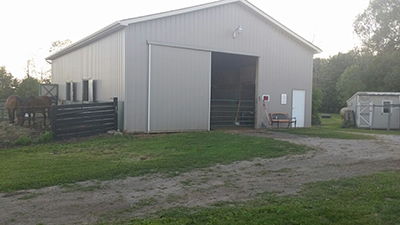
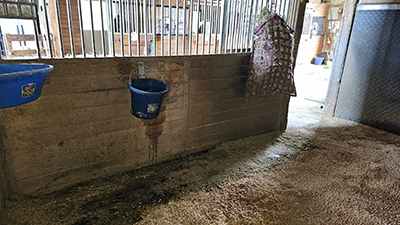
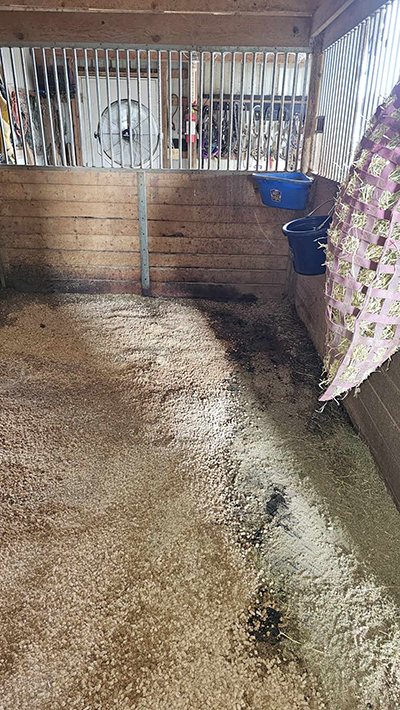
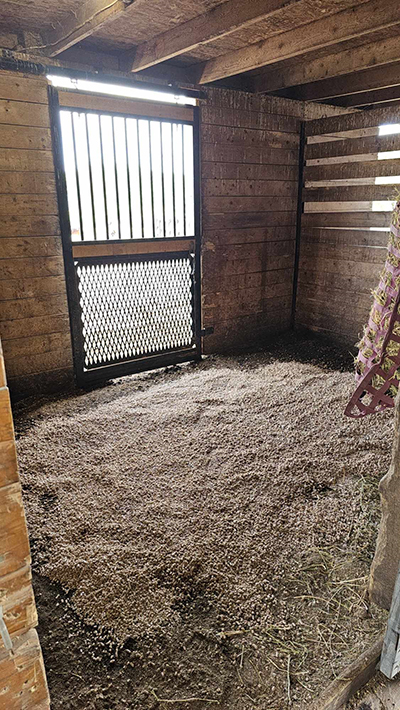
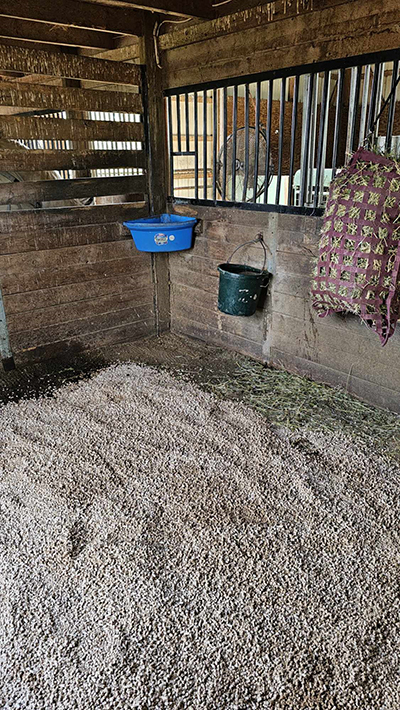
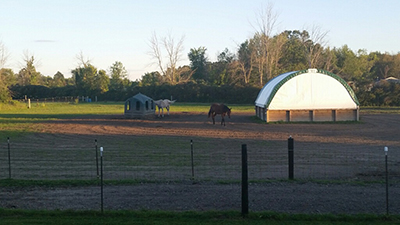
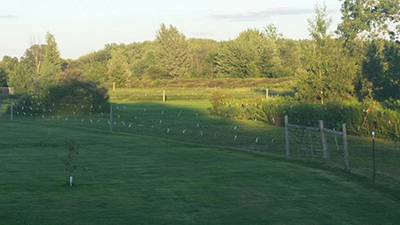
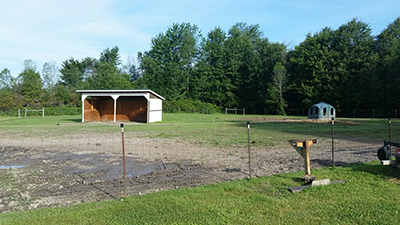
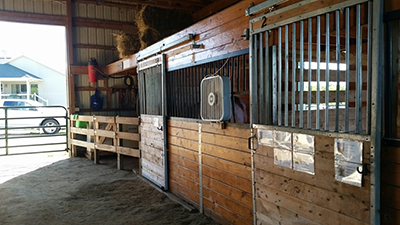
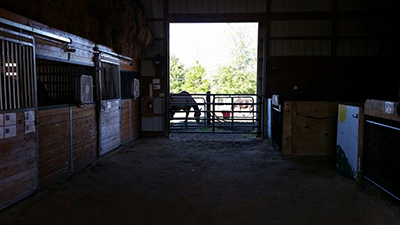
Are the organization's rules, restrictions and warnings (signage) conspicuously posted in easily accessible locations? Yes
Are the organization's emergency contacts, including veterinarian contact information, conspicuously posted in easily accessible locations? Yes
Are human and equine first aid kits easily accessible? Yes
Regarding all shelters where horses are housed including run-in sheds:
Do horses have assigned stalls in the barn/structure(s) or exclusively assigned shelter locations where they are separated from other horses with a barrier? Yes
How many hours per day, on average, are horses stalled or restricted to these sheltered exclusive shelter locations? 4-8
How often are the stalls/shelters cleaned, i.e., kept in good repair and free of standing water, accumulated waste, sharp objects and debris? 6-7 Days a Week
Do all stalls/shelters allow horses to lie down, stand up and turn around and provide protection from inclement weather (wind, sleet, rain, snow and extreme temperatures)? Yes
Are stalls/shelters kept in good repair, with adequate ceiling height, and free of standing water, accumulated waste, sharp objects and debris? Yes
Are floors constructed and maintained for both good drainage and traction? Yes
Is there a ventilation and circulation system in place to allow free flow of air to control temperature, and humidity, and to prevent air stagnation? Yes
Is wiring inaccessible to horses and maintained for safety in all areas of facility? Yes
Are fire prevention/protection measures (fire alarms, extinguishers and sprinkler systems) maintained and in good working order? Yes
Is there adequate lighting to ensure safety in all areas of facility? Yes
How many hours per day, on average, are horses turned out:
Equines are out 4 to 8 hours per day
Equines are out 9 to 15 hours per day
Equines are out 24/7
Equines are out 24/7 except they are brought in to feed
The following describes the pastures at this facility:
This facility has a written plan in place for pasture management, which includes guidelines for seeding, fertilizing, irrigation, mowing, dragging, harrowing, manure removal, removal of debris, the control of poisonous plants, and a schedule for cleaning
A dedicated staff person(s) is responsible for pasture management
All pastures are fenced to prevent escape or injury
Electric fencing is used; electric wires or tape fence are visibly marked
Fencing checks, such as broken or missing planks, loose fence posts, exposed or loose nails, detached wires, etc., are done regularly
Pastures are rotated
Pastures have natural protection for equines (i.e., trees)
Not Checked:
This facility does not have pastures where equines can graze on pasture grass
Barbed wire is used for fencing
Pastures have man-made protection for equines (i.e., shelters)
This facility does not have pastures where equines can graze on pasture grass
Barbed wire is used for fencing
Pastures have man-made protection for equines (i.e., shelters)
The following describes the turnout areas other than pastures at this facility:
This facility has a written plan in place for the maintenance of turnout areas, which includes a schedule for cleaning, manure removal, and dragging
A dedicated staff person(s) is responsible for the maintenance of turnout areas
All turnout areas are fenced to prevent escape or injury
Electric fencing is used; electric wires or tape fence are visibly marked
Turnout areas have man-made protection for equines (i.e., shelters)
Fencing checks, such as broken or missing planks, loose fence posts, exposed or loose nails, detached wires, etc., are done regularly
Not Checked:
This facility does not have turnout areas
Barbed wire is used for fencing
This facility does not have turnout areas
Barbed wire is used for fencing
The following policies and procedures are in place at the facility to restrict public access and to keep horses safe:
The property owner, staff member or caretaker lives on the premises and ensures that public access is restricted and is responsible for the security of the facility and equines
There is a practice in place to monitor equines overnight
No Trespassing signs are posted
Hold Harmless signs are posted
Visitors are only permitted at specific times
Visitors are only permitted in specific areas
The property is fitted with a security system that is monitored internally by staff (or the property owner)
Not Checked:
A security guard is present at night
By Appointment Only signs are posted.
Authorized Personnel Only signs are posted
Entrance gates are locked at night
The property is fitted with motion lights
The property is fitted with a security system monitored by police or a professional service
The perimeter of the property is fully fenced
A security guard is present at night
By Appointment Only signs are posted.
Authorized Personnel Only signs are posted
Entrance gates are locked at night
The property is fitted with motion lights
The property is fitted with a security system monitored by police or a professional service
The perimeter of the property is fully fenced
Equine Care/Emergency Preparedness: Gail Hirt - Main Farm for Beyond The Roses Equine Rescue (*Main) 2026 and 2025 This section is required.
Horse Health Care/Barn Management Records: What system is used to collect and store health/horse care records?
Onsite computer with onsite backup storage system
Our organization utilizes a software application to maintain records
The organization utilizes its own system to maintain records
The following items are consistent with our feed management plan and practices:
Equines are provided with individualized feeding plans, including supplements, according to the equine's age, breed/type, condition, size, work level and any health issues, consisting of nutritious food provided in sufficient quantity and access to adequate natural forage, or be fed daily, or as recommended by the organization's veterinarian
Feed plans are determined in consultation with a veterinarian
Supplement plans are determined in consultation with a veterinarian
Equines are fed grain in individual stalls
Staff and/or volunteers are trained in proper feed measurements and protocols and observed periodically to ensure they are feeding correctly
The feed chart is centrally located and updated as needed
The area(s) where hay, feed, grain, and supplements are stored are kept clean, free of debris and chemicals, and protected from weather and other animals in rodent-proof and mold-proof containers and grain bins
Feed, supplements and hay types are clearly labeled
Water sources, i.e., buckets, troughs, automatic waterers, etc. are kept clean, free of contaminants, debris and chemicals, protected from weather and other animals, and be positioned or affixed to minimize spillage.
Medications are kept in a secure area
Not Checked:
Equines are fed grain in groups
Equines are fed grain in groups
Is clean, potable water available at all times for all equines? Yes
Hoof Care: How often is hoof care provided for each equine? Every 4-8 weeks and when an issue arises
Dental Care: How often is dental care provided for each equine? Annually and when an issue arises
Horse checks: How often are equines visually and physically checked by personnel at the facility? Every day or 6 days a week
Our organization has the following parasite and fly/insect control protocols in place, including remedies used to control flies and insects:
Our organization follows the parasite control guidelines of our veterinarian, including fecal testing and de-worming
Fly/Insect Control Remedies:
Fly parasites
Fly Traps and Tapes
Fly Spray Repellent
Fly Masks
Fly Sheets
Fans
Not Checked:
The following represent the biosecurity practices in place at facility:
Our organization follows the biosecurity guidelines of our veterinarian
Sick, affected and/or quarantined equines do not have contact with other equines or other animals
The organization has a written biosecurity plan
Staff are trained in best practices related to biosecurity
Volunteers are trained in best practices related to biosecurity
A specific individual is trained and assigned to care for sick, affected and/or quarantined equines
Sick, affected and/or quarantined equines are cared for last if the caretaker must also care for healthy equines
Restricted access signs are posted at primary points of access to sick, affected and/or quarantined equines
Hand sanitizers are available at all primary points of access to sick, affected and/or quarantined equines
Footbaths are available at all primary points of access to sick, affected and/or quarantined equines
Manure and bedding from sick, affected and/or quarantined equines is removed from the facility - not put in open air piles, and not spread on pastures
Quarantine areas, such as stalls, aisle ways, paddocks, and common areas, are cleaned (and needed, disinfected) after conclusion of the quarantine.
Trailers/vans used by sick, affected and/or quarantined equines are cleaned and disinfected after each use and cleaning takes place away from where equines are sheltered
Equipment used by sick, affected and/or quarantined equines is not shared
Equipment used by sick, affected and/or quarantined equines is cleaned of organic debris and disinfected after each use
Latex gloves, or equivalent gloves, are worn when working with sick, affected and/or quarantined equines
Not Checked:
Equines are not quarantined on arrival.
Equines are not quarantined on arrival.
Additional information on biosecurity:
Horses are provided their grain individually in stalls, with grain bags and in separate areas to make sure they are getting the grain and supplements they individually need.
The following represent the manure removal practices in place at facility:
Manure is piled in an area where equines are not located
Manure is hauled, sold or given away
Our organization adheres to the manure management guidelines set by the state, local authorities, and/or our organization's veterinarian
Not Checked:
Manure is stored in dumpster(s)
Manure piles are covered
Manure piles are composted or spread on pastures
Manure is stored in dumpster(s)
Manure piles are covered
Manure piles are composted or spread on pastures
The following steps are taken to help staff and volunteers readily identify each horse on the property:
Equines are assigned the same exclusive stall/shelter location each day
Name plates are located on the stall/shelter location
Photos are located on the stall/shelter location
Equines wear halters with nametags
A notebook or binder with photos and information on each equine is easily accessible
A map/diagram is posted showing the location of each equine with equine names and photos
Equine photos and profiles are available on the website
Staff/volunteers are provided training on conformation, markings, colors, and breeds
Team leaders work with new staff/volunteers until they are able to identify the equines
Not Checked:
Staff and volunteers are provided with an information packet with equine profiles, including photos and detailed descriptions
Staff and volunteers are provided with an information packet with equine profiles, including photos and detailed descriptions
Our organization has the following policies and procedures in place pertaining to tack, apparel and equipment:
Saddles are shared
Bridles are shared
Bits are shared
Blankets, sheets and turn out apparel are fitted and utilized for each equine appropriate to the equine's needs and the weather conditions
Blankets, sheets and turn out apparel are cleaned regularly as needed
Riding Tack is always cleaned at least weekly
Riding Tack is inspected for overall working condition before each use by trained personnel
Riding Tack is assessed for fit before each use by trained personnel
Riding Tack is assessed for fit by trained personnel when an equine's body condition changes
Riding Tack is assessed for fit by trained personnel when an equine's disposition changes
This facility enlists the services of a professional saddle fitter at least once a year
Riding Tack is stored in a climate-controlled location
Helmets are shared
Helmets are cleaned/disinfected after each use
Helmets are replaced after a fall
Helmets are replaced at least every five years.
Not Checked:
All equines have specifically assigned apparel, equipment and tack (saddles/bridles if ridden) that is not shared
Saddle pads are shared
Blankets are shared
Sheets are shared
Turnout apparel is shared
Halters are shared
Riding Tack is always cleaned after each use
Riding Tack is cleaned only when needed
Assigned riding tack is clearly labeled
No equines are ridden; saddles, bridles, etc. not applicable.
All equines have specifically assigned apparel, equipment and tack (saddles/bridles if ridden) that is not shared
Saddle pads are shared
Blankets are shared
Sheets are shared
Turnout apparel is shared
Halters are shared
Riding Tack is always cleaned after each use
Riding Tack is cleaned only when needed
Assigned riding tack is clearly labeled
No equines are ridden; saddles, bridles, etc. not applicable.
Emergency Preparedness: Gail Hirt - Main Farm for Beyond The Roses Equine Rescue: *Main This section is required.
The following plans, policies, and procedures are in place at the facility to handle emergencies and address weather related issues, fire safety procedures, and/or any additional hazardous scenarios the facility could potentially experience:
Emergency procedures are posted prominently
The facility owns or has access to a generator
The facility maintains at least two weeks of hay, feed, shavings and medications
The facility collects and maintains medical information from staff, volunteers, and clients
The facility maintains appropriate liability and/or workers' compensation insurance
The organization has a written emergency preparedness/safety plan (EPP)
Not Checked:
The written EPP addresses the following areas: Local fire department and/or the state's emergency planning department procedures
Medical emergencies for clients, staff, and volunteers
Medical emergencies for equines
Evacuation plans
Fire
Natural Disasters - thunderstorm, hurricanes, earthquakes, tornados, etc
Protocols to notify emergency personnel
Building/facility exit plans
Not Checked:
Power outages
Terrorist attacks
Power outages
Terrorist attacks
The facility follows the specific procedures to help PREVENT emergency situations:
Smoking is strictly prohibited
NO SMOKING signs are posted prominently
Hay is stored away from permanent or temporary structures where equines are stalled
Permanent or temporary structures where equines are stalled are kept free of dust, cobwebs, trash, cleaning rags, and other flammable items
Aisles and doorways are kept clear
Not Checked:
Heaters with automatic shutoff settings are used
Heaters with automatic shutoff settings are used
How often are the following checked or performed?
Fire Extinguishers are checked: Monthly
Smoke detectors are checked: Not at all/NA
Fence lines are checked: Daily
Turnout Areas are checked: Daily
Sprinkler systems are checked: Not at all/NA
Fire drills are conducted: Quarterly
Review of safety protocols with staff are conducted: Weekly
Review of safety protocols with volunteers are conducted: Weekly
The Emergency Preparedness Plan is reviewed and updated: Weekly
Equine Transportation: 2= Onsite: 2 (1 + 1) + Offsite: 0
2-horse van/trailer with truck:
1 Owned onsite 1 Access onsite but not owned
GOVERNANCE, MANAGEMENT & FINANCIAL REPORTING
Financial ReportingBudget: $10K to $100K
Month Fiscal Year Ends: 12
Type of Financial Reporting (Audit, Review, Compilation): Review
Type of IRS Filing (990, 990-EZ, 990-N): 990
Governing Body:
Board meetings per year: 3
Number of Board Members: 6 Number of Voting Board Members: 6
Board Compensation:
Is the Board Chair compensated? No Is the Treasurer compensated? No
Are there any other Voting Board Members that are compensated? No
Board/Staff Relationships:
Are any members of the Board, Staff or Program Participants related to each other through family or business relationships? Yes
If yes, provide the name, title, responsibility and family/business relationship of each Board, Staff member and/or Program Participant.
The President Sharman Privett is married to a Board Member Bruce Privett.
Board/Staff Affiliations:
Are any Board members providing services to your organization or compensated by your organization, or are any Board members or staff members associated with and/or compensated by another organization with a relationship or business affiliation to your organization? Yes
If yes, provide the name, title, responsibility and family/business relationship of each Board and/or Staff member, and the name of the related organization.
Gail Hirt, Executive Director owns one of the facilities.
Conflict of Interest:
Does your organization have a written conflict of interest policy that ensures that any compensated board member is a NON-VOTING (Independent) board member or that any compensated board member or any board member related to a compensated staff member, independent contractor, or any related board members, or any individual or organization that might benefit from a board decision, abstains from voting on issues impacting such compensation and requires officers, directors or trustees, and key employees to disclose at least annually in writing interests that could give rise to conflicts? Yes
Compliance:
Below is a list all local, state and federal licenses held by the organization, and/or accreditations or compliances with the published standards of an accrediting organization, if applicable: Licensed by State of Michigan 2023-2024
Accredited by Thoroughbred Aftercare Alliance
Organization documents available on our website:
Equine Intake Guidelines
Adoption/Foster Agreement
Organization documents available on request:
Most recent Financials
Most recent IRS Form 990
Most recent Annual Report
Equine Intake Guidelines
Adoption/Foster Agreement
Volunteer Handbook
Bylaws
Staff & Volunteers:
Chief Staff Officer (CSO): Gail Ann Hirt, Executive Director
Employees/Independent Contractors: Full-Time: 0 Part-Time: 0 Volunteers: 10
Staff Recruitment, Screening and Training processes including employees and independent contractors:
Not applicable; We do not have paid staff or utilize contractors to perform staff functions.
Volunteer Recruitment, Screening and Training processes:
Prospective volunteers complete a written application/agreement
Our organization has a practice in place to ensure that the organization has sufficient knowledge of the background of prospective volunteers that may impact the safety of your clients and your horses, such as whether prospective volunteers have been convicted of a sexual offense or convicted for animal cruelty or neglect. Such practices must comply with local, state, and federal mandates.
Volunteers required to complete a Liability Release/Hold Harmless Agreement
Volunteers are required to provide Emergency Medical Information
Volunteers provide parent/guardian information if applicable
Volunteers carry current health insurance
Volunteers are evaluated on an annual and as needed basis or with any change in their job description
Volunteers are updated on all the organization's policies and procedures on an annual and as needed basis or with any change in policy or procedure
Volunteers receive training that includes safety guidelines, confidentiality, equine handling, equine identification, and emergency procedures; additional training is job specific
Volunteers are assigned a supervisor (staff member and/or senior volunteer) and is responsible for keeping their supervisor up to date on work related activities
The supervisor assesses the volunteer's abilities and assigns specific duties to the volunteer based on their skills
The organization holds regular orientation sessions for volunteers and prospective volunteers that includes an overview of the organization, its mission, activities, volunteer responsibilities and expectations, safety guidelines, and a tour of the facility
Not Checked:
Volunteers are required to sign a Photo Release
Prospective volunteers are required to undergo a Background Check
Volunteers have written job descriptions
The organization records and maintains written attendance information and hours on every volunteer
The organization provides a Volunteer Handbook to every volunteer
The Volunteer Handbook (available either online or in print) includes volunteer-related information, such as hours of work, dress code, cell phone usage, and the protocol for dismissal
The Volunteer Handbook is reviewed annually and updated
Volunteers are subject to Random Drug Screening
Volunteers are required to sign a Photo Release
Prospective volunteers are required to undergo a Background Check
Volunteers have written job descriptions
The organization records and maintains written attendance information and hours on every volunteer
The organization provides a Volunteer Handbook to every volunteer
The Volunteer Handbook (available either online or in print) includes volunteer-related information, such as hours of work, dress code, cell phone usage, and the protocol for dismissal
The Volunteer Handbook is reviewed annually and updated
Volunteers are subject to Random Drug Screening
DISCLAIMER: The listing of this organization on this site is not an endorsement. EQUUS Foundation Guardians receive a star rating of 4 being the highest to 1 being the lowest based on the degree to which the organization meets the EQUUS Foundation standards for equine welfare and business practices.
If you have concerns about this organization, please contact us here.
© Copyright 2018 EQUUS Foundation 718 4.00
© Copyright 2018 EQUUS Foundation 718 4.00